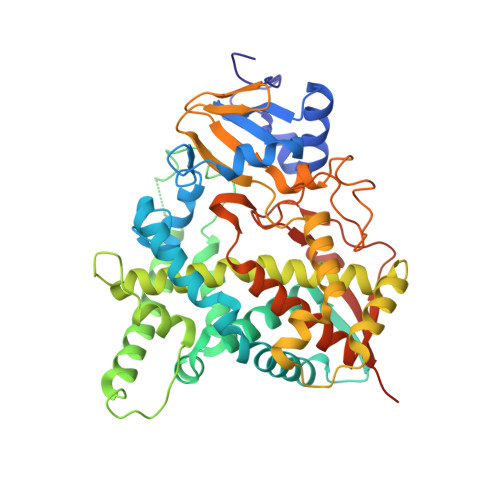Complexes of Trypanosoma Cruzi Sterol 14Alpha-Demethylase (Cyp51) with Two Pyridine-Based Drug Candidates for Chagas Disease: Structural Basis for Pathogen-Selectivity
Hargrove, T.Y., Wawrzak, Z., Alexander, P.W., Chaplin, J.H., Keenan, M., Charman, S.A., Perez, C.J., Waterman, M.R., Chatelain, E., Lepesheva, G.I.(2013) J Biol Chem 288: 31602
- PubMed: 24047900
- DOI: https://doi.org/10.1074/jbc.M113.497990
- Primary Citation of Related Structures:
3ZG2, 3ZG3 - PubMed Abstract:
Chagas disease, caused by the eukaryotic (protozoan) parasite Trypanosoma cruzi, is an alarming emerging global health problem with no clinical drugs available to treat the chronic stage. Azole inhibitors of sterol 14α-demethylase (CYP51) were proven effective against Chagas, and antifungal drugs posaconazole and ravuconazole have entered clinical trials in Spain, Bolivia, and Argentina. Here we present the x-ray structures of T. cruzi CYP51 in complexes with two alternative drug candidates, pyridine derivatives (S)-(4-chlorophenyl)-1-(4-(4-(trifluoromethyl)phenyl)-piperazin-1-yl)-2-(pyridin-3-yl)ethanone (UDO; Protein Data Bank code 3ZG2) and N-[4-(trifluoromethyl)phenyl]-N-[1-[5-(trifluoromethyl)-2-pyridyl]-4-piperi-dyl]pyridin-3-amine (UDD; Protein Data Bank code 3ZG3). These compounds have been developed by the Drugs for Neglected Diseases initiative (DNDi) and are highly promising antichagasic agents in both cellular and in vivo experiments. The binding parameters and inhibitory effects on sterol 14α-demethylase activity in reconstituted enzyme reactions confirmed UDO and UDD as potent and selective T. cruzi CYP51 inhibitors. Comparative analysis of the pyridine- and azole-bound CYP51 structures uncovered the features that make UDO and UDD T. cruzi CYP51-specific. The structures suggest that although a precise fit between the shape of the inhibitor molecules and T. cruzi CYP51 active site topology underlies their high inhibitory potency, a longer coordination bond between the catalytic heme iron and the pyridine nitrogen implies a weaker influence of pyridines on the iron reduction potential, which may be the basis for the observed selectivity of these compounds toward the target enzyme versus other cytochrome P450s, including human drug-metabolizing P450s. These findings may pave the way for the development of novel CYP51-targeted drugs with optimized metabolic properties that are very much needed for the treatment of human infections caused by eukaryotic microbial pathogens.
Organizational Affiliation:
From the Department of Biochemistry, School of Medicine, Vanderbilt University, Nashville, Tennessee 37232.
















